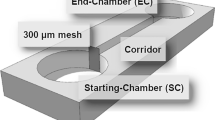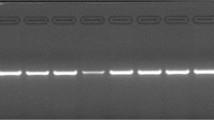Abstract
An analysis of departure from Hardy–Weinberg equilibrium is presented for a set of three troglobitic beetles each with one larval stage (Speonomus hydrophilus, zophosinus and colluvii) from the central Pyrenees. These populations show an important deficiency of heterozygotes (positive Fi and FIS values: 0·4) for all polymorphic loci. Several hypotheses are put forward and examined in relation with the species' biology. The local populations are highly subdivided into demes receiving limited numbers of immigrants from neighboring demes. The spatial structure of the underground environment, associated with the trapping methods used, could lead to the pooling of individuals from a number of separate demes; within these demes the close cohabitation of individuals of several generations, the lack of a larval dispersal stage, the female fertility and the rhythm of matings may give rise to an important inbreeding effect.
Similar content being viewed by others
Article PDF
References
Beaumont, A R. 1982. Variations in heterozygosity at two loci between year classes of a population of Chlamys opercularis from a Scottish sea-loch. Mar Biol Lett. 3, 25–34.
Beck, M L, and Price, J O. 1981. Genetic variation in the terrestrial isopod, Armadillidium vulgare. The Journal of Heredity, 72, 15–18.
Beck, M L, and Price, J O. 1985. Genetic variation and differentiation in Armadillidium vulgare (Isopoda: Oniscoidea). Genetica, 66, 169–171.
Berger, E N, and Sutherland, J. 1978. Allozyme variation in two natural populations of Daphnia pulex. Heredity, 41, 13–23.
Berger, E M. 1983. Population genetics of marine gastropods and bivalves, 563–596.In Russel-Hunger, W. D. (ed.) The Mollusca, Vol 6, Ecology, Academic Press. N.Y.
Black, W C, and Krafsur, E S. 1985. Electrophoretic analysis of genetic variability in the house fly (Musca domestica. L.). Biochemical Genetics, 23, 3–4, 193–203.
Cavalli-Sforza, L L, and Bodmer, W F. 1971. The genetics of Human Populations. Freeman, San Francisco, CA.
Crouau-Roy, B. 1986. Structure génétique des populations et des espèces chez des coléoptères troglobies (Speonomus). Etude des mécanismes de spéciation. Thèse d'Etat, University of Montpellier, pp. 1–300.
Delay, B, Sbordoni, V, Cobolli-Sbordoni, M, and De Matthaeis, E. 1980. Divergences génétiques entre les populations de Spenomus delarouzeei du Massif du Canigou (Coleoptera, Bathysciinae). Mémoires de Biospéologie, 7, 235–247.
Deleurance-Glacon, S. 1963. Recherches sur les Coléoptères troglobies de la sous famille des Bathysciinae. Ann Sci nat Zool, 12, 1–172.
Eanes, W F, and Koehn, R K. 1978. An analysis of genetic structure in the monarch butterfly, Danaus plexippus L. Evolution, 32, 784–797.
Gregorius (ed.), Population Genetics in Forestry. Springer-Verlag, N.Y.
Hedrick, P W. 1986. Average inbreeding or inbreeding equilibrium. Amer J Hum Genet, 38, 538–557.
Howarth, F G. 1983. Ecology of cave Arthropods. Ann Rev Entomol, 28, 365–389.
Jeannel, R. 1924. Monographie des Bathysciinae. Biospeologica. Arch zool exp gén, 63, 1–436.
Juberthie, C, Delay, B, and Bouillon, M. 1980. Sur l'existence d'un milieu souterrain superficiel en zone non calcaire. C R Acad Sci, 290, 49–52.
Juberthie, C, Delay, B, Durand, J, Juberthie-Jupeau, L, Bouillon, M, and Ruffat, G. 1981. Etude écologique morphologique, biométrique et biologique de Speonomus zophosinus (Coléoptères Bathysciinae). Mém Biospéol, VIII, p. 95–124.
Juberthie-Jupeau, L, and Cazals, M. 1984. Modalités de l'accouplement dans différentes populations du complexe Spenomous delarouzeei. Mém Biospéol, 11, 165–172.
Karlin, S, and Feldman, M W. 1968. Analysis of models homozygotes, heterozygotes matings. Genetics, 59, 117–136.
Kimura, M, and Ohta, T. 1971. Theoretical aspects of population genetics. Princeton Univ. Press, Princeton.
Kirby, G C. 1975. Heterozygote frequencies in small subpopulations. Theoretical Population Biology, 8, 31–48.
Lewontin, R C, and Cockerham, C. 1959. The goodness of fit for detecting natural selection in random mating populations. Evolution, 13, 561–564.
Mort, M A, and Wolf, H G. 1985. Enzyme variability in large-lake Daphnia populations. Heredity, 55, 27–36.
Murray, J. 1964. Multiple mating and effective population size in Cepaea memoralis. Evolution, 18, 284–291.
Nei, M. 1973. Analysis of gene diversity in subdivided populations. Proc Nat Acad Sci, USA, 70, 3321–3323.
Nei, M. 1986. Definition and estimation of fixation indices. Evolution, 40, 643–645.
Sassaman, C. 1978. Dynamics of a lactate dehydrogenase polymorphism in the wood louse Porcellio scaber latr. Evidence for partial assortative mating and heterosis in natural populations. Genetics, 88, 591–609.
Selander, R K. 1970. Behavior and genetic variation in natural populations. Amer Zool, 10, 53–66.
Singh, S M, and Green, R H. 1984. Excess of allozyme homozygosity in marine molluscs and its possible biological significance. Malacologia, 25, 569–581.
Singh, S M, and Zouros, E. 1978. Genetic variation associated with growth rate in the American oyster (Crassostrea virginica). Evolution, 32, 342–353.
Snyder, T P, and Linton, M C. 1984. Population structure in black flies: allozymic and morphological estimates for Prosimulium mixtum and P. fluxum (Diptera: Simuliidae). Evolution, 38, 942–946.
Sokal, R R, and Rohlf, F. 1969. Biometry: the principles and practice of statistics in biological research. Freeman, San Francisco.
Sturgeon, K B, and Mitton, J B. 1986. Allozyme and morphological differentiation of mountain pine beetles Dentroctomus ponderosae hopkins (Coleoptera: Scolytidae) associated with host tree. Evolution, 40, 290–302.
Valenzuela, C Y. 1985. Algebraic and epistemological restrictions in studies on Hardy-Weinberg equilibrium. Am Naturalist, 125, 744–746.
Yasuda, N, and Morton, N E. 1967. Studies on human population structure. In Crow, J. F. and Neel, J. U., Proceedings on the third international Congress of human genetics: polenary sessions and symposia John Hopkins. Univ. Press Baltimore, 245–265.
Zouros, E, and Krimbas, C B. 1969. The genetics of Dacusolae. III. Amount of variation at two esterase loci in a Greek population. Genet Res, 14, 249–258.
Zouros, E, and Singh, S M, and Miles, H E. 1980. Growth rate in oysters: an overdominant phetontype and its possible explanations. Evolution, 34, 856–867.
Zouros, E, and Foltz, D W. 1984. Possible explanations of heterozygote deficiency in bivalve molluscs. Malacologia, 25, 583–591.
Wright, S. 1943. Isolation by distance. Genetics, 28, 114–138.
Wright, S. 1965. The interpretation of population structure by F. statistics with special regard to systems of mating. Evolution, 19, 395–420.
Wright, S. 1969. Evolution and the genetics of populations, vol. 3. The theory of gene frequencies. Univ. Chicago Press, Chicago.
Sytsma, K J, and Schaal, B A. 1985. Genetic variation, differentiation, and evolution in a species complex of tropical shrubs based on isozymic data. Evolution, 39, 582–593.
Author information
Authors and Affiliations
Rights and permissions
About this article
Cite this article
Crouau-Roy, B. Genetic structure of cave-dwelling beetles populations: significant deficiencies of heterozygotes. Heredity 60, 321–327 (1988). https://doi.org/10.1038/hdy.1988.49
Received:
Issue date:
DOI: https://doi.org/10.1038/hdy.1988.49
This article is cited by
-
Characterization of 25 new microsatellite markers for the fin whale (Balaenoptera physalus) and cross-species amplification in other cetaceans
Molecular Biology Reports (2020)
-
Geographical variation in shell morphology and isoenzymes of Helix aspersa Müller, 1774 (Gastropoda, Pulmonata), the edible land snail, from Greece and Cyprus
Heredity (1994)
-
Genetic population structure of the Postglacial relict diving beetle Hydroporus glabriusculus Aubé (Coleoptera: Dytiscidae)
Heredity (1992)
-
Genetic population structure in a troglobitic beetle (Speonomus zophosinus)
Genetica (1986)



